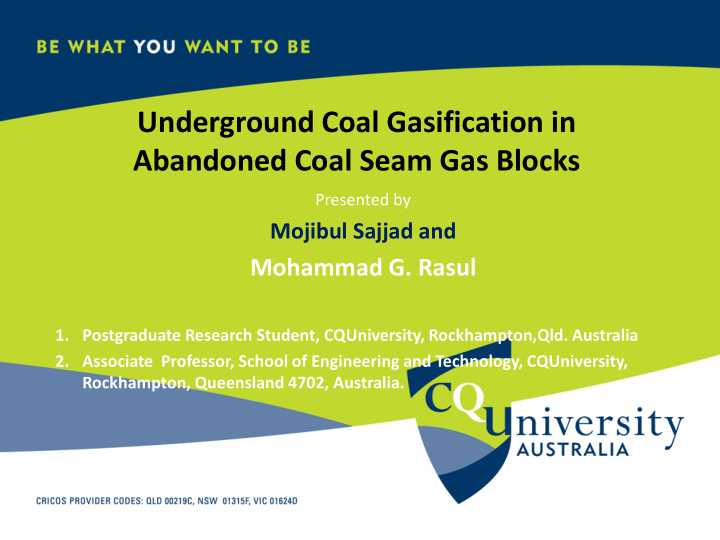



Underground Coal Gasification in Abandoned Coal Seam Gas Blocks Presented by Mojibul Sajjad and Mohammad G. Rasul 1. Postgraduate Research Student, CQUniversity, Rockhampton,Qld. Australia 2. Associate Professor, School of Engineering and Technology, CQUniversity, Rockhampton, Queensland 4702, Australia.
Presentation Outline Introduction UCG in Global Perspective UCG in Australia Commitment for Sustainable Engineering Identified Issues Optimization; A new Approach Conclusion and Recommendations
Introduction Coal is the major source of Electricity generation. I. Global context- 40% II. Australia- 80% Coal extraction methods (conventional method) - Underground mining - Open cast mining Unconventional Coal exploitation (Deeper Position) - Coal Seam Gas ( 95-97% CH4 ) extraction - Underground Coal Gasification Coal → CO 2 , CO, NO X , SO X , Fly ash, Bottom ash etc. Global trend → Clean Coal Technology
Coal Seam Gas Extraction and GHG Emission Coal Seam Gas → Very Low GHG emission fuel. → Minimum Recovery of coal resource (~5%). → Affects ground water . → Stimulation activity such as coal body fracturing . → Huge capital investment. “Work over” of Production well based on well head gas flow rate.
Underground Coal Gasification; An Overview Underground Coal Gasification (UCG) - Converted coal in-situ to a “Syngas” - Energy recovery from coal (~70%) - Fly ash, Bottom ash left underground - Demonstrated success in global context. - Subsidence effect minor (deeper coal) - Aquifer contamination insignificant for deep seated coal body. Global trend USA, Canada, Australia, Europe, China, South Africa, Pakistan and others.
Underground Coal Gasification Process 1. Oxidation/Combustion 2C + O 2 → 2CO C + O 2 → CO 2 2. Gasification C + H 2 O → CO + H 2 C + 2H 2 O → CO 2 + 2H 2 CO + H 2 O → CO 2 + H 2 C + 2H 2 → CH4 3. Pyrolysis/devolatization H 2 , CH 4, N 2, Tar,Solid Char
UGC in Australia “Western world’s leading practice in UCG” 3 pilot projects conducted in Queensland, Australia as : Kingaroy Project by Cougar Energy, Chinchilla Project by Linc Energy, Another project near Dalby run by Carbon Energy (associated with CSIRO). Chinchilla Project , A Ground Breaking Achievement of UCG Coal seam depth at 140 m and thickness 10 m, air injection as oxidant. Over than 35,000 tons of coals were gasified (output pressure apx. 10 bar, temperature 300 o C 100% availability, 1999-2002). 95% recovery of the coal resource. (continued)
UGC in Australia “Western world’s leading practice in UCG” Operated 5 successive UCG activity. Run the GTL (gas to liquid) plant. Success for controlling process & shut down practices. Expertise development & skills for commercialization of UCG technology. Scientifically validated numerical results. Expands global business, acquired primitive IP share of this technology in Uzbek plant. Cougar Energy’s plant shut down due to aquifer contamination with Benzene. Queensland State government set goal before commercial operations by Linc and Carbon Energy until “demonstrate safe decommissioning by extinguishing the fires, shutting off reactions and preventing groundwater contamination” Entrepreneurs are planning to close their business in Australia.
Commitment for Sustainable Engineering Economic Modelling of UCG ; A Sustainable Technology IRR and Pay Back Period. Environmental issues. Clean coal technology. GHG emission control. Post operation CCS at coal cavity. Best practices of engineering.
Identified Issues ; UCG Activity in Depleted CSG Blocks Coal deposits at deeper position in Queensland, are ideal for permanent CO 2 sequestration.
Optimization ; A New Approach for Uneconomic Coal Deposite Optimization for Maximum resource extraction. • • Best practices of UCG technology. • Cost effective Power Generation. • Integrated Engineering approach for CSG+UCG+IGCC+CCS within CSG+UCG in-situ coal formation. + IGCC+CCS • “H 2 ” separation from Syngas for CSG+UCG + IGCC FCV as Zero emission fuel . CSG+UCG (Deeper Coal) CSG
Conclusion and Recommendations An engineering approach for Eco-friendly and cost effective exploitation technique for Australian deep seated coal deposits. Seeking provision for UCG operation in the depleted CSG blocks Carbon sequestration after event exploitation H 2 separation for Fuel Cell Vehicle(FCV). Joint Collaboration with global partners.
References Walker, L. Underground Coal gasification : A Clean Coal Technology Ready for Development. The Australian Coal Review 1999. Blinderman, M.S. and R.M. Jones, The Chinchilla IGCC Project to Date: Underground Coal Gasification and Environment , in 2002 Gasification Technologies Conference, . 2002: San Francisco, USA. Gasification Technologies Council, G.T. Council, Editor. 2012, www.gasfication.org. Bhutto, A.W., A. Bazmi, and G. Zahedi, Underground Coal Gasification : From Fundamentals to Application. Progress in Energy and Combustion Science 2013. 39 : p. 189 -214. Moran, P.C., P.J.d. Costa, and E.P.C. Cuff, Independent Scientific Panel Report on Underground Coal Gasification Pilot Trials . 2013, Queensland Independent Scientific Panel for Underground Coal Gasification (ISP): Queensland, Australia. Kempka, D.I.T., B.A.N. Nakaten, and e. al. Economic Viability of In-situ Coal Gasification with Downstream CO 2 Storage . Esterle, J. Introduction to Coal Geology for Gas Reservoir Characterisation .
Thank You
Question?
Recommend
More recommend